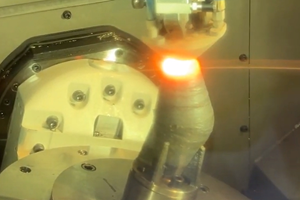Frictionless Machining Reduces Heat, Chatter
Friction resulting from moving machine components rubbing together can create vibration and heat buildup, both of which can cause problems during machining operations. One machine from NTC America uses hydrostatic components to eliminate sources of friction for high-precision, small-parts machining.
Share





When problems occur in machining operations, vibration and heat are possible culprits. Thermal growth resulting from heat buildup in the spindle can adversely affect accuracy, while vibration that causes chatter can not only ruin a cut, but also cause tools to break prematurely. In most machine tools, both vibration and heat can stem from a single source—friction caused by metal components rubbing together as the machine elements move and the spindle turns.
To eliminate friction, NTC America (Novi, Michigan) offers a machine in which the only metal-to-metal contact is between the cutting tool and the workpiece. Designed for high-precision work on small parts, the Zµ3500 VMC operates without linear guideways, roller bearings or ballscrews. Rather, it is equipped with hydrostatic ways, a hydrostatic/hydrodynamic hybrid spindle and scaled linear motor drives.
According to the company, this design provides quiet, nearly inertia-free and accurate operation, making the machine useful for the demanding requirements of medical devices and tight-tolerance dies and molds. In fact, the machine’s accuracy, rigidity and repeatability are sufficient to allow roughing, semi-finishing and finishing on a single platform, says Larry Jones, regional sales manager for NTC.
Unlike machines that use rolling, metal elements as the interface between moving and stationary components, the Zµ3500 incorporates a pressurized film of oil. Sliding along oil keeps machine components from contacting one another, eliminating friction that causes vibration and heat buildup. Moreover, having this configuration in the ways alleviates stick-slip motion, and backlash is also not a problem because the linear motors can change direction almost instantaneously, Mr. Jones says. This enables the machine to hold concentricity to less than one micron on circularity tests.
Mr. Jones likens the effect to a game of air hockey. “The components float on the film of oil like the puck floats on air,” he explains. “When you tap it, it takes off, hits a corner, and takes off another way. It looks like there’s no inertia for it to overcome.”
Many machine tools must run for a few minutes in order to “warm up” before operators can set zero points and undergo other preparations for operation. That’s because as the machine runs and temperatures increase, bearings and other metal components in the machine expand slightly and throw off accuracies, Mr. Jones says. However, with its non-metal-contact design, as well as a 60-gallon chiller unit that recirculates the hydrostatic oil and keeps it cool, the Zµ3500 is ready for machining within seconds of startup. Additionally, operators don’t need to program offsets into the control to compensate for inaccuracies resulting from thermal growth.
The machine is also much quieter than many of its counterparts because the only machining noise is that of the tool meeting the workpiece. A quieter, less-invasive shop floor can be a boon to employees, Mr. Jones says. Additionally, with no metal contact, machine components are less liable to wear out. This can extend component life and ease repair and maintenance costs. According to Mr. Jones, changing the oil every 2 years and changing the oil filter every 6 years is sufficient to maintain the hydrostatic systems.
With XYZ axis travels of 13.78 Ă— 11.81 Ă— 11.81 inches, the machine can achieve 787 ipm feed rates at a maximum spindle speed of 30,000 rpm. The worktable measures 17.72 Ă— 14.17 inches and can accommodate parts as heavy as 220 pounds. The spindle uses a 17.5/25-hp motor and HSK E32 toolholders.
Related Content
Additive/Subtractive Hybrid CNC Machine Tools Continue to Make Gains (Includes Video)
The hybrid machine tool is an idea that continues to advance. Two important developments of recent years expand the possibilities for this platform.
Read MoreLean Approach to Automated Machine Tending Delivers Quicker Paths to Success
Almost any shop can automate at least some of its production, even in low-volume, high-mix applications. The key to getting started is finding the simplest solutions that fit your requirements. It helps to work with an automation partner that understands your needs.
Read MoreShop Tour Video: Inside a Family-Owned Machine Shop Specializing in High-Precision Plastics
In this episode of “View From My Shop,” East Coast Precision Manufacturing guides us through their plastics job shop. Learn how this shop has quickly and inexpensively built out its shop floor, as well as how it formed a niche for itself during difficult business conditions.
Read MoreTsugami Lathe, Vertical Machining Center Boost Machining Efficiency
IMTS 2024: Tsugami America showcases a multifunction sliding headstock lathe with a B-axis tool spindle, as well as a universal vertical machining center for rapid facing, drilling and tapping.
Read MoreRead Next
AMRs Are Moving Into Manufacturing: 4 Considerations for Implementation
AMRs can provide a flexible, easy-to-use automation platform so long as manufacturers choose a suitable task and prepare their facilities.
Read MoreMachine Shop MBA
Making Chips and Modern Machine Shop are teaming up for a new podcast series called Machine Shop MBA—designed to help manufacturers measure their success against the industry’s best. Through the lens of the Top Shops benchmarking program, the series explores the KPIs that set high-performing shops apart, from machine utilization and first-pass yield to employee engagement and revenue per employee.
Read More






















